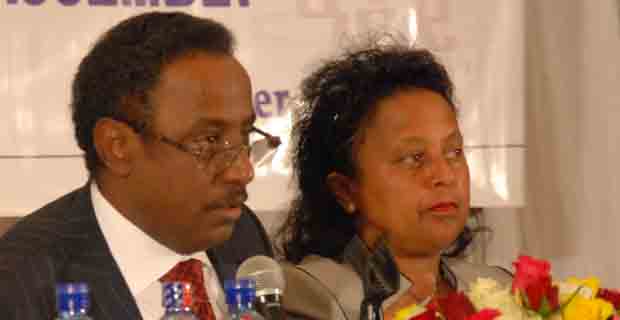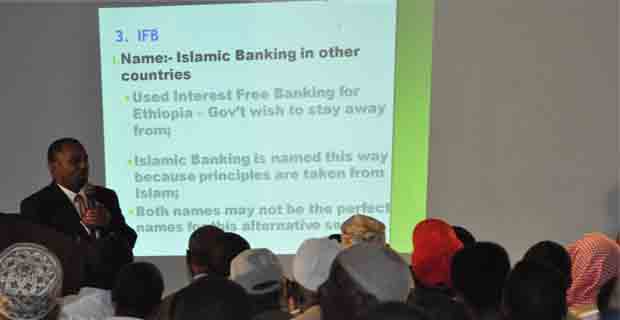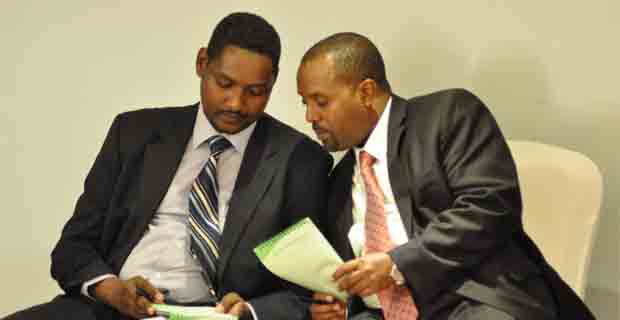.
China offers scholarship for 50 Ethiopian university students
ADDIS ABABA, Dec. 19 — The Chinese government through its Embassy in Ethiopia on Thursday offered scholarship for about 50 students of Addis Ababa University (A.A.U.).
The scholarship provides financial assistance of five years to needy students to enable them to pursue their studies at the University. There will be a total of 250 students in five years who will get scholarships.
At the signing ceremony of the scholarship on the premises of A.A.U, Admasu Tsegaye, A.A.U. President, recalled that Addis Ababa University and the Chinese universities had earlier started academic collaboration in different field of studies.
The president said the collaboration with China and the Chinese universities has positive impact as it contributes to the development endeavor of Ethiopia.” We are feeling the impact of our collaboration with the Chinese universities and with the Chinese government,” he said. “Today, we are very happy that the Ambassador offered scholarship for needy Addis Ababa University students. So, this scholarship will assist 50 students for five years. It will provide financial support for the needy and for very good students.”
The president said the collaboration is growing and benefiting the two sides. He also expressed belief that the collaboration between A.A.U. and the Chinese universities would further be strengthened in the future.
“We also started offering courses in Amharic language in Beijing foreign language university. So, the collaboration is a two-way; and so, we are benefiting; both the peoples of Ethiopia and China are benefiting from this type of relationship,” said Tsegaye.
The relationship between the peoples of Ethiopia and China is strong these days, he said.
There are many Chinese companies and industrial zone in Ethiopia, he said, revealing that the university would organize workshop in the near future to facilitate and enable industry- university link. Xie Xiaoyan, Chinese Ambassador to Ethiopia, stated that investing in university students is investing in the future leaders of a country.
Stating that the overall relations between Ethiopia and China are growing, Xie expressed happiness to contribute the education sector in Ethiopia.”So, I am so happy that I can contribute in a limited way to education causes in this country, especially at the Addis Ababa University. We provide financial support for students of excellence, and students in need to further their
studies at the university,” said the ambassador.
“I will continue to do that and this is just one of the steps I have taken. But the bigger picture is the overall relationship between our two countries, especially in the last few years. We have seen growing exchanges in many fields,” he said.
Xie also stated that the students would work for common causes and development of the country. He also highlighted the role of language learning in economic benefit and also in furthering cultural exchanges and better understandings among different peoples. Some of the students who have been awarded the scholarship told Xinhua that they are very happy about the scholarship.
One of the awardees, Getu Tegegn, a Chinese language student at the Addis Ababa University, said all of them feel good and they are happy about the scholarship. It will further strengthen the relations between the two countries, he said.
Mebrahtu Solomon, another student, who also visited China last year, said the scholarship from China motivate the students to further work hard. The Chinese government and the Chinese Embassy give us many scholarship opportunities; and the relationship between Ethiopia
and China is increasing from time to time, he said.
http://english.peopledaily.com.cn/203691/8491012.html
.
French Trade minister expected Thursday in Ethiopia
The French foreign trade minister, Mrs Nicole Bricq, is due on Thursday in Ethiopia for a two-day visit aimed at strengthening the economic ties between the two countries, official sources told PANA on Wednesday.
The minister said that the visit was under the framework of the extension of the Elysee summit on “Peace and Security in Africa” held on 6 and 7 December in Paris. This is to strengthen the economic ties with a country that has recorded an average growth rate of 8% over the past few years and whose 2010-2015 five-year plan sets huge investments in terms of infrastructure.
The minister, who will be accompanied by officials of 30 companies, including 9 small and medium size firms and intermediary size businesses, will hold talks with the Ethiopian Prime minister, Haile Mariam Desalegn, the deputy-Prime minister, Debretsion Gebremichael, also minister of Communication and Information technology, and the minister of Finance and Economic Development, Sufian Ahmed.
Bricq will also visit the Hilina enriched food processing center Plc, a partner of the French company Nutriset, that has specialized in the production of food to fight malnutrition.
She will visit the wind power site of Ashegoda, Africa’s biggest wind power station, fully equipped by a French company.
French economic presence in Ethiopia is through direct foreign investments by French companies estimated at over 100 million euro in two sectors – the distribution of oil products (Total group) and viticulture (Castel group).
France is among the main European investors in Ethiopia after the United Kingdom, Italy and the Netherlands.
http://www.africanmanager.com/site_eng/detail_article.php?art_id=21169
.
Ethiopia Picked Lazard to Procure its Credit Rating
Ethiopia has picked Lazard Ltd, French investment bank and asset management firm to procure credit rating companies for its debut sovereign Eurobond, Reuters reported today.
In interview with Reuters in October, Ethiopia’s Prime Minister Hailemariam Desalegn said, the country will also consider “not only a Eurobond but other bonds as well”, once it secured its credit rating. a debut sovereign Eurobond next month.
“We chose a French company. The second phase will be to initiate a rating for the country,” Sufian Ahmed, Ethiopia’s minister for finance and economic development, told a business forum attended by a delegation of 30 French firms.
The French delegation included officials from French banks BNP Paribas and Societe Generale, according to Reuters.
Buoyed by massive government spending on infrastructure and a growth in its services and agriculture sector, Ethiopia’s economy is set to grow 7.5 percent in each of the next two fiscal years, according to the IMF.
http://www.2merkato.com/news/alerts/2763-ethiopia-picked-lazard-to-procure-its-credit-rating
.
ERA Awarded Chinese Contractor Dessie-Kutaber-Tenta Road Project
Ethiopian Roads Authority (ERA) today signed a 1.5 bln birr contract with China First Highway Engineering Co. Ltd (CFHEC) for the Dessie-Kutaber-Tenta road upgrade project, Walta Information Center (WIC) reported.
The 67.5 km long ten meters wide asphalt road upgrading project will link South Wello Zone to North Wello in the Amhara Regional State.
The Dessie-Kutaber-Tenta has a 24 km asphalt road built during the Italian occupation, which is now in poor condition from years of service. The remaining 34.5 km is a gravel road will be upgraded to asphalt.
“This project is part of the 2013/14 fiscal year annual plan. We believe the project will contribute to the overall economic growth of the area and it’s environs,” Zaid Woldegebriel said during a signing of the agreement at ERA’s headquarters today.
Financing for the project will come from the Ethiopian government and the Kuwait Fund, according to WIC.
“We treasure this opportunity. This project will be very challenging but we will make sure we finish it ahead of time with the required quality,” Yong Sheng, representative of CFHEC, said during a signing ceremony.
Established in April, 1963, CFHEC is an affiliate of China Communications Construction Company which has 15 years presence in Ethiopian road construction. CCCC major recent road projects in Ethiopia include the Addis Ababa – Adama Expressway and Africa Avenue (Bole Road) projects.
.
Tsehay Launched Construction on US$ 200 million Real Estate Project
Tsehay Real Estate Plc launched construction of the US$ 200 million International Center, at Yeka Sub City, Addis Ababa, Capital reported.
Qian Tang, a shareholder in Tsehay, said the urban complex will become the second icon of Sino-African cooperation next to the African Union Headquarters. After the copletion of the complex, the Chinese Chamber of Commerce in Ethiopia, Chinese funded organizations, Chinese merchants, a Sino-Ethiopian industrial and commercial organization will move into the complex. This will become the largest urban complex in Ethiopia and an architectural landmark, Tang added.
Tsehay Real Estate plans to complete the construction of the residential buildings within the next two year and eighteen months later, the commercial center, Capital reported quoting Tang.
The construction is being done in cooperation with the Institute of Architecture Design and Research, the Chinese Academy of Science and Qian Tang Construction Plc., Qian Tang told Capital.
“We want to help develop the urban area, create a comfortable living space and boost the real estate industry,” Tang said.
The center will host star hotel, international standard offices, residences, a commercial pedestrian walkway, cinema, fitness amenities and children’s amusement park.
.
Agency Availed 3.6m Hectare for Agricultural Investment
Ethiopia’s Agriculture, Investment and Land Administration Agency availed 3.6 million hectares arable land to investors in the agriculture sector, Ethiopian News Agency reported.
Speaking on a training provided for investors engaged in coffee plantation in Oromia and South Ethiopia Peoples’ States, Agency Representative Asres Argaw said 470,000 hectares land has already been provided for Ethiopian and foreign investors for the cultivation of cotton, palm trees and sugarcane.
The Ethiopian government is working to increase the private sector’s participation in the agriculture sector, Asres said.
Asres said the conducive investment policies and strategies as well as incentives attracted more investors to engage in coffee plantations, a government priority area.
The Agriculture, Investment and Land Administration Agency is a newly established agency aimed at providing integrated support for investors and improve land utilization and production.
.
African centre eyes linking minerals to local industry
The African Mineral Resource Centre, which is launched in Maputo Mozambique during the third African Union African mining ministers meeting today (December 16, 2013) envisages creating linkages between the continents rich minerals and the local industries.
The center secures 15.3 million funding from Canadian government envisages to become the centre of excellence and strategic support provider to African countries in mining related issues.
The envisaged centre of excellence is primarily funded by Canada and Australian governments, who are also known for their investment and the expertise in mining sector globally. Reports show that unless the continent properly manages its mineral resources, which is estimated to have value of $30 billion by 2030, its mineral resources will continue to be curse instead of blessing.
.
Ethiopia Welcomes Turkish Investment – State Minister
Members of the Turkish business delegation exploring possible investment opportunities in Ethiopia said they explored vast opportunities for investment in Ethiopia.
During a discussion State Minister for Foreign Affairs, Dewano Kedir, conducted with the delegation, head of the delegation and Board Chairman of a sugar corporation, Mr. Metin Uysal said they were very excited about the opportunities and expressed their enthusiasm to start investment in Ethiopia immediately.
Mr. Uysal also appreciated the support and attention given to them so far and said that Turkey regards Ethiopia as a very important ally. The state minister told the delegation that Ethiopia and turkey witness very strong relationship and has an additional foundation in investment and trade.
The State Minister affirmed the readiness of the government to work closely with Turkish businesses and urged the delegation to start operation in their respective sectors quickly. The fifteen member delegation is composed of business representatives from the steel industry, solar energy appliances manufacturing, mining, textile and garment, food processing and sugar production.
http://allafrica.com/stories/201312200098.html
.
Fund Awards Two Grants for Agricultural Infrastructure in Africa
Washington — The African Development Bank’s Agriculture Fast Track Fund (AFT), a new multidonor trust fund created to increase agricultural productivity and reduce poverty, recently announced the recipients of the fund’s first two project preparation grants.
The project preparation grants will help attract investment in agricultural infrastructure projects in Côte d’Ivoire and Tanzania while strengthening links from farmers to markets to tables across Africa, the U.S. Agency for International Development (USAID) said in a December 17 press release.
“As a key supporter of the Agriculture Fast Track Fund, the U.S. government is fulfilling its commitment under the New Alliance for Food Security and Nutrition,” said USAID Administrator Rajiv Shah. “These exciting grants are helping to address food production and food security programs in East and West Africa, and are the first step in leveraging donor funding to catalyze private sector investment in support of Africa’s long-term economic growth and food security.”
In all, six firms from Tanzania, Côte d’Ivoire and Ethiopia were approved for funding under the AFT’s first round of grants, with a total funding amount of nearly $3.2 million.
Created as part of the New Alliance for Food Security and Nutrition and launched in May, the AFT is a nearly $28 million fund to spur agricultural infrastructure development in African countries that are members of the New Alliance, including Burkina Faso, Côte d’Ivoire, Ethiopia, Ghana, Mozambique and Tanzania.
Launched in 2012, the New Alliance for Food Security and Nutrition is a joint commitment by African leaders, private sector partners, and Group of Eight members to accelerate responsible investment in African agriculture and lift 50 million people out of poverty by 2022.
The AFT finances project preparation grants, enabling firms to finance project design work such as feasibility studies, market analyses and environmental impact and other activities required by banks and other investors to issue commercial loans. The fund is supported by the governments of the United States, Sweden and Denmark.
These are among the first grants to improve African food security and nutrition:
- An award of $551,990 to the National Federation of Food Production Cooperatives to support project preparation for a food production and food security program in Côte d’Ivoire. The project aims to build six warehouses, three rice milling plants and four cassava processing plants, and secure equipment such as drip irrigation systems.
- An award of $220,850 to Darsh Industries for project preparation to set up a tomato processing plant in Iringa, Tanzania. Darsh will build, staff and purchase cargo trucks and equip at least eight collection centers in Iringa to serve as buying and outreach stations for local farmers.
The AFT is currently accepting applications for qualified projects through December 31. To learn more about the AFT, including how to apply for grants, go to the AFT website.
http://allafrica.com/stories/201312191541.html
.
Gov’t, employers, employees need to develop dialogue: Ministry
The Ministry of Labor and Social Affairs urged the need to improve dialogue between government, employers and employees and build peaceful industrial relation.
Speaking in a relevant meeting held in Adama Town in Oromia State, the State Minister Dr Zerihun Kebede said establishing peaceful relation between employers and employees is important in ensuring transformation of the country’s agriculture led economy to industry led.
The Minister urged strong dialogue culture need to be developed among the three to realize development.
Peaceful industrial relation director with the Ministry, Zerihun Gezahegn on his part said the workshop is aimed at creating strong and peaceful relation among the three entities and improve production and productivity.
Over 80 participants drawn from the House of Peoples’ Representatives, Employers’ Federation, Confederation of Employees Associations, regional and city administrations and stakeholders are taking part in the three-day workshop.
.
Ministry urges stakeholders to work closely to end gender based violence
The Ministry of Women, Children and Youth urged stakeholders to work closely to end gender based violence.
In a relevant meeting held in Gambella Town, the Minister Zenebu Tadesse through a representative said stakeholders should join efforts to end violence against women.
She urged the need to end gender based violence and ensure the social and economic benefit of women.
She urged government agencies and NGOs to contribute share to the efforts of the government towards creating a community that hate and fight violence against women.
State Representative Asheni Asteni on his part said the state government is working hard to end gender based violence and harmful traditional practices in the State.
.
Related articles-



























































